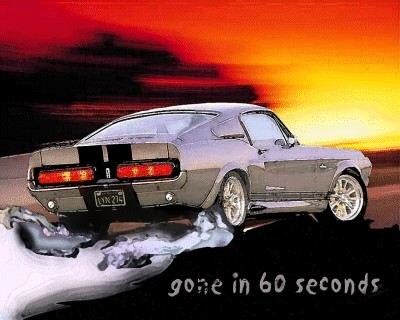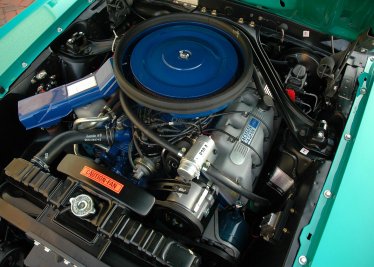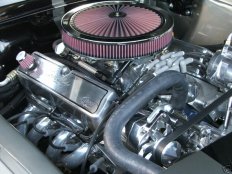






Ford 90 Degree Family
221 cubic inch
" Bore and stroke of 3.50 X 2.87.
" One of the rarest engines in its' class.
" Produced from 1962 to 1963
" Compression ratio of 8.7:1
" 143 Horsepower
260 cubic inch
" A hybrid of the 221.
" Bore and stroke of 3.80 X 2.87
" Larger intake and exhaust ports.
" 164 Horsepower
" Was used in one of the first Cobra's.
289
" Bore and stroke 4.00 X 2.87
" 200 Horsepower w/ 282 ft-lb torque
" Two barrel Ford carb
" Hydraulic camshaft
" In 1964, the 289 was available at 210 horsepower, four barrel carb, cast iron intake manifold and compression ratio of 9.0:1
" In 1965 the 289 became was now at 225 horsepower, larger four barrel carb and a compression ratio of 10.0:1 This engine was available till the 1967 model year.
" In 1968, the engine was reduced to 195 horsepower.
289 HiPo
" Available from 1964 to 1967
" Higher nodularity content in block w/ larger two bolt main caps.
" Counter weight balanced crankshaft.
" 3/8 inch rod bolts
" Screw in rocker studs w/mechanical lifter camshaft.
" Dual point distributor.
" Ford 480 cfm four-barrel carb atop a cast-iron intake manifold.
" 271 horespower at 6,000 RPM w/312 ft-lb's of torque.
302
" Produced in 1968
" Cast iron crankshaft
" forged rods
" cast pistons
" hydraulic camshaft
" available with 2 or 4 barrell carburator
" horsepower varied from 210 to 230 depending on carburator.
" Standard 302 was equipped with 2 barrel from 1969 to 1983.
302 Tunnel Port
" Did not see production for consumer market.
" Commonly referred to as the 302 TP for Tunnel Port
" Pushrods were fitted inside a sleeve
" Intake ports were oversized
" Intake/Exhaust was 2.12inches and 1.54inches
" Two versions available, one with conventional rocker arms for the Trans Am race series and the other using Nascar shaft mounted rocers.
" Engines were built by Ford foundry and not by the racing circuit
302 Boss
" Top performer of the 90 degree family.
" Production from 1969 to 1970.
" Available in Mustang 302 Sportsroof and Mercury Cougar Eliminator only.
" Four bolt mains
" Screw in frost plugs
" Canted valves, 2.23 in. / 1.71 in.
" Cylinder heads from Ford's 335 Series family.
" Threaded rocker arm studs
" Push rod guide plates.
" Stamped steel sled-fulcrum rockers
" Mechanical lifter camshaft
" dual plane, single four barrell aluminum intake.
" Holley 780cfm carb.
351 Windsor
" Not to be confused with the 351 Cleveland.
" A basic 302 with extended deck height with thicker cylinder walls
" Primarily the only interchangeable part are the heads with other small blocks from the 90 degree family.
" In 1969, the 351 Windsor reached its' highest horsepower rating of 290 at 5800RPM
Ford Y Block Series Family
239 cubic inch
" Cast iron crankshaft, intake and exhaust
" Cast-aluminum pistons
" Mechanical camshaft
" Aavailable in Ford cars in 1954 and 1955 Ford trucks
256 cubic inch
" Used only on Mercury vehicles and in F-series Ford trucks
" Compression ratio of 7.5:1
" 161hp at 4400RPM
272 cubic inch
" Two versions available for 1955
" Two barrel carb with 7.6:1 compression and 162hp
" Four barrel carb with 8.5:1 compression and 182hp
" In 1956 horsepower varied with automatic or manual transmission
" In 1957, the 272 cubic inch reached 192 horsepower
292 cubic inch
" First introduced in the T-bird and Montclair
" All used four barrel carb in 1955, but horsepower varied, but average around 200 depending with manual or automatic transmissions.
" Bore and stroke: 3.75x3.30 in.
" Following years were produce less horsepower, until its' demise in 1964
312 cubic inch
" Largest Y Block of its kind
" Bore and stroke: 3.80x3.44 in.
" Two versions were introduced, both with four barrel carbs and dual exhausts.
" Introduced, once again in the 1957 T-Bird, it gained critical aclaim for producing horsepower over 300 while equipped with a Paxton supercharger
Ford 335-Series Family
The 335 Series consisted of versions of the 351 and 400 blocks. It lasted from 1970 to 1975.
351 Cleveland
" canted-valve cyclinder heads.
" bore and stroke of 4.00 X 3.50.
" a light weight block to beat.
" one of the most desirable V8 engines Ford had to offer.
" a two barrel or four barrel setup.
" From 1970 to 1971 the 351 boosted between 250 to 240 horsepower.
" As time progress, the 351 Cleveland saw lessor horsepower until its' demise in 1975.
" the 351 Cleveland four barrel came with dual exhausts, a higher compressions ratio, larger intake/exhaust valves and four bolt mains during the first year of production.
" the 351 Windsor, which belongs to the 90 degree V8 family and bears no resemblance or connection to the 351 Cleveland.
351 CJ
" Introduced in the fall of 1971
" mostly of four bolt mains, however there are some with two bolt mains.
" possessed a spread bore bolt pattern cast iron manifold
" Autolite carb 4300-D
" Horsepower varied from approximately 280 during the first year of production down to 265 by 1973.
351 Boss
" Most desirable
" only available in the 1971 Boss 351 Mustang
" Four bolt mains
" high nodular iron crankshaft
" solid lifter camshaft with screw in studs
" adjustable rockers
" an aluminum four barrel intake
351 HO
" In 1972, Ford rolled the 351 Boss over into the 351 High Output for the new year.
" Slighltly less desirable, the 351 High Output used the spread bore bolt pattern cast iron manifold
" Autolite 4300-D.
" With a milder camshaft, the output of the 351 HO was about 275 horsepower.
351 M and 400
" By 1975 the 351 Modified was issued with Cleveland heads
" a two barrel carb.
" hydraulic lifters.
" a cast iron intake manifold.
" a two barrel carb.
" the 351 Modified and the 400 which was introduced since 1971, are virtually identical with very few exceptions.
Ford MEL Series
In 1958, came the introduction of the MEL series engines. These were some of the largest and heaviest V8 engines Ford had ever built.
383 cubic inch
" Developed for the Mercury line of vehicles.
" Bore and stroke of 4.30 X 3.30 inches.
" Had a two year history starting in 1958 and lasting till 1960
" Most of these engines in the two years were known as the Marauder
" The Mercury Marauder engines of 1958 came with either 312 horsepower or 330 horsepower, both packed with a four barrel carburator.
" In 1959, the Marauder engine was considered a mid range of its' predecessor with a stock horsepower of 322.
" In its' last year, the 383 cubic inch Marauder was dropped to 280 horsepower.
410 cubic inch
" Less common of the MEL series is the 410 cubic inch
" Bore and Stroke of 4.20 X 3.70
" 10.5.1 compression
" Holley four-barrel carb and hydraulic lifters.
" 475 pounds of foot torque
" Also be reffered to as the E-475 engine.
" In 1958, Edsel Corsair and Citation models used the 410 cubic inch as their only preference for engine types.
430 cubic inch
" commonly referred to as the Bulldozer of the MEL series and lasted from 1958 to 1965
" In its' "suped up" version, the 430 was commonly referred to as the Super Marauder and came with three two barrel carburators.
" bore and stroke of 4.29 X 3.7 inches
" Compression rations started at 10.5.1 but soon began to decline late in 1959 to 10.0.1 at 350 horsepower.
" The higher horsepower versions of the 430 remained within its first year of production with horsepower of 365, 375 and of course 400.
" In 1959 the horsepower slowly began to reduce, yet hold a moderate 345 ponies even with a slightly less compression ratio of 10.0.1.
" In 1960, the big 430 cubic inch used a milder camshaft, producing 315 horsepower.
" 1963 when the 430 got an overhaul with new pistons and a four barrel carb, pushing compression to 10.1.1 and a horsepower rating of about 345.
" It could be found in the 1958 Lincoln Continental Convertible, rating 400 horsepower and nearly 500 foot pounds of torque.
" Mercury also used the 430 cubic inch until 1960.
462 cubic inch
" By 1966, it replaced its' predecessor the 430.
" bore and stroke of 4.38 X 3.83 inches.
" hydraulic lifters and a four barrel carb.
" the 462 was used for its' smoothness in large passenger vehicles.
" It lasted for only two years.
Ford FE Series
332 cubic inch (1958 - 1959)
" Compression ratio 9.5:1
" Bore and stroke of 4.00X3.30
" two-barrell @ 240 hp
" 1958 series option w/four-barrell @ 265 hp
" mechanical camshaft w/machined combustion chambers
" last year of production, compression ratio 8.9.:1 @ 225 hp
352 cubic inch
" bore and stroke of 4.00X3.50
" engine for the '58 T-bird
" four barrell carb @ 300 hp
" compression ratio 10.2.:1
" cast iron crankshaft
" forged steel rods, mechanical-lifter camshaft w/machined combustion chambers or cast chambers by 1959.
" By 1960, the 352 HP was available with an aluminum intake manifold producing approximately 360 hp.
360 cubic inch
" Used in Ford trucks
" Lower compression engine with heavy duty internal parts
361 cubic inch (1958 - 1959)
" Bore and stroke 4.0469X3.50
" 10.5:1 compression ratio w/303 hp
" In 1959, the 360 cubic inch used cast chambers reducing compression and horsepower.
390 cubic inch (1961-1976)
" Bore and stroke 4.05X3.78
" Three versions available
" 1961-1963: 390 cubic inch with 9.6:1 compression ratio, four barrell carb @300 hp.
406 cubic inch
" Introduced in 1962
" Bore and stroke 4.13x3.78
" Same block as 390 HP
" Few 1963 blocks came with cross bolt mains.
" Revised oil galleries.
410 cubic inch
" This is a 390 block with a 428 crankshaft
" Four barrell carb.
" The stroke is increased .020 in for a total of 3.98 inches
" Only used in Mercury vehicles from 1966 to 1967
427 Low Riser
" Available through 1963-1964
" Cast iron crankshaft and solid lifter camshaft
" Intake 2.04 (2.09 inch in 1964) with 1.66 exhaust valves
" Some of these engines had cross-bolt mains.
" Cast aluminum intake manifolds.
" Single and dual four barrell carburators.
" Horsepower varied from 410 to 425 depending on setup.
" 11.5.1 compression
427 Medium Riser
" 1965 to 1967 all 427 blocks were side oilers.
" Forged steel crankshaft
" Cap screw connecting rods
" Cross bolt mains
427 High Riser
" Introduce in 1964
" Tallest cyclinder ports and intake manifold allowed for greater air/fuel mixture
" Single and dual four barrell
" Cast iron crank
" solid lifter camshaft
" Cross bolt mains
427 Tunnel Port
" Available in 1967
" Options included Tunnel Port cyclinder heads, four barrell aluminum intake or dual four barrell aluminum intake.
" Much like the 427 medium riser in all other regards.
427 SOHC
" Available as an over the counter option only.
" Cast aluminum cyclinder heads
" hemi-spherical combusiton chambers
" stainless steel valves
428 cubic inch
" Introduced in 1966
" Bore and stroke of 4.13X3.98
" Cast iron crankshaft
" forged-steel connecting rods
" cast iron intake manifold
" 345 horsepower @ 10.5:1 compression ration
" Variations of the 428 existed throughout its' life span, including the 428 Police Interceptor, 428 Thunderjet and 428 Marauder.
" The Police Interceptor contained an aluminum intake, high performance camshaft and beefier connecting rods to produce 360 hp.
428 Cobra Jet
" Standard was 2.09 inch intake and 1.66 inch exhaust valves.
" Cast iron intake manifold identical to the aluminum one on the police interceptor.
" Cast iron exhaust manifolds.
" Two-bolt main block
" Between 345-360 horsepower
428 Super Cobra Jet
" Internal structure differences included Lemans type cap screw rods
" The capscrews were shorter than the 427's to clear the block
" Externally balanced
" External engine oil cooler
Ford 385-Series Family
Although there were several variations to the engines of the 385-series family, only two displacements were available---the 429 cubic inch and the 460 cubic inch. Both were introduced in 1968 and lasted until 1973. These engines were heavier and larger than Ford's predecessor---the FE Family.
429 (Thunderjet)
" two-bolt main bearing cap
" Bore and Stroke 4.36x3.59
" cast-iron crankshaft
" forged-steel connecting rods with 3/8 inch rod bolts
" cast-aluminum pistons
" hydraulic lifter camshaft
" 2.08 inch/1.66 inch intake/exhaust valves
" non-adjustable rocker arms
" cast-iron intake manifold
" 4 barrel or 2 barrel carburator
" Was available in Ford and Mercury automobiles
" 429 Cobra Jet
" Four-bolt main engine block (with exception to some early 1970 models).
" Larger cylinder heads---2.25 inches/1.72 inches intake/exhaust.
" Rocker arms were stamped steel 1.73:1 ratio with sled type fulcrums, threaded screw-in rocker studs and pushrod guide plates.
" The rocker arms on the 429 cubic inch Cobra Jet were also adjustable prior to 1969.
" Cobra Jet used a Rochester Quadrajet carburetor atop a spread-bore cast-iron manifold.
429 Super Cobra Jet
" 4 bolt main engine blocks
" Forged aluminum pistions
" Mechanical lifter camshaft
" Adjustable rocker arms
" 780cfm Holley four-barrel carb
429 Boss
" All aluminum cast cylinder heads
" Cresent type combustion chambers
" Intake/Exhaust valves of 2.28in and 1.90inch
" Exhaust valves are "D" shaped
" 4 oil galleries
" Identified by casting 429HP on block
" Higher iron nodularity content with thicker cylinder walls
" 2 Versions of the 429 Boss existed, they were 820-S & 820-T
" Forged steel cross-drilled crankshaft
" Forged aluminum pistons
" Aluminum dual plane manifold w/735cfm Holley four barrel carb
429 Nascar
" Larger Outboard bolts in #1 main bearing cap.
" Deck height was grooved for O rings.
" Larger machined refliefs for exhaust pushrods
" Longer street rods, than the Boss 429-820S type
" Some blocks had full hemi design, others crescent type
" Stainless steel intake valves
" Magnesium valve covers and intake manifold.
460
" Produced from 1968 to 1996.
" Available in Ford, Mercury and Lincoln.
" Same as 429, but with longer stroke. (3.85 inch)
" During its earlier years, pre 1973, horsepower was rated at 365. After 1972 horsepower ranged from 208 to 275.
" Intake/exhaust valves are 2.08/1.66
" Intake/exhaust valves for the Police Interceptor 460 heads (from 1973-'74) measure 2.19/1.66





